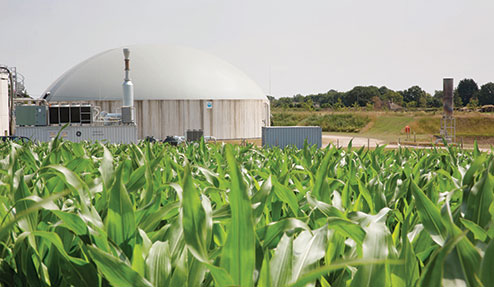Biogas industry guide tackles crop feedstock fears

Voluntary guidelines on how farmers can manage potential environmental risks from growing crop feedstocks for AD have been published.
The initiative by the Anaerobic Digestion & Biogas Association (ADBA) and other stakeholders aims to address concerns about the “unintended consequences” of large areas of crops, such as maize, being grown for AD. Some of these were raised in the government’s Anaerobic Digestion Strategy and Action Plan for England, published in 2011.
Selecting crops for AD
- Is the crop suitable for the farm’s soil type, climate, topography?
- Will it fit into the existing rotation and what benefits could it deliver? For example blackgrass control, opportunity for overwintered stubbles, soil structure/organic matter, pest/disease break
- Does the farm have the machinery and agronomic expertise?
- Can you meet the sowing and harvest periods needed for optimum dry matter yield?
- What are the implications of crop choice on harvest date and future soil management? Some feedstocks (for example, maize and beet) need more post-harvest management to reduce soil erosion, run-off and the like.
- How will crop choice impact habitats and wildlife? Consider buffer strips, or undersowing crops with grass/pollinator plants. Look at using green manures, cover crops, other stewardship options to enhance biodiversity.
- Go to adbiogas.co.uk/resources/crop-best-practice-document for more information.
The guidance shows how careful crop selection and integration within existing farming systems can avoid negative impacts such as soil erosion or monoculture cropping, and can also deliver agronomic or environmental benefits, such including blackgrass control, improved soil structure and breaking pest and disease cycles.
See also: Shared ownership of farm renewables set to grow
“Less than 1.5% of the UK’s total crop area is used for purpose-grown AD crops, so despite recent growth it’s still a very small area,” said ADBA chief executive Charlotte Morton. “But increasing attention to the wider environmental impacts is inevitable, so it is very important the industry takes the lead by signing up to best practice to ensure what we do is as sustainable as possible.”
Welcoming the code of practice, environment, food and rural affairs minister Dan Rogerson said the government wanted to see a greater use of waste in AD, but where systems used crops the code provided a good start to highlight best growing practice and addressed environmental concerns.
Widespread adoption of voluntary best practice could pave the way for greater promotion of AD, added NFU chief renewable energy adviser Jonathan Scurlock. “Our backing for AD needs to be carefully qualified, but now we have this guide perhaps it is time to up the game about promoting the wider benefits AD could deliver.”
That greater recognition of AD’s wider benefits was essential for future growth of the sector, especially given the falling Feed-in Tariffs and Renewable Heat Incentive support, said Ms Morton.
Market maturity
Industry estimates suggested that while the AD sector had experienced significant growth over recent years, this could plateau within two years, said KWS maize product manager John Burgess.
“We estimate market maturity will be reached in 2016 at about 115 crop-based AD plants. Potentially the industry could get up to 140-150 plants, but I can’t see it’ll be any more than that.”
Maize was the dominant feedstock for existing AD plants, accounting for about 70% of the 40,000ha of feedstock grown in 2014, but other crops were gaining in popularity, he said. Hybrid rye had increased its share from 4% to 13% between 2011 and 2014 and could account for a quarter of the 70,000ha of crop AD feedstock expected to be required by 2020. Maize was forecast to account for 55% of that area, while sugar/ energy beet and other crops such as wholecrop cereals made up the remainder.
